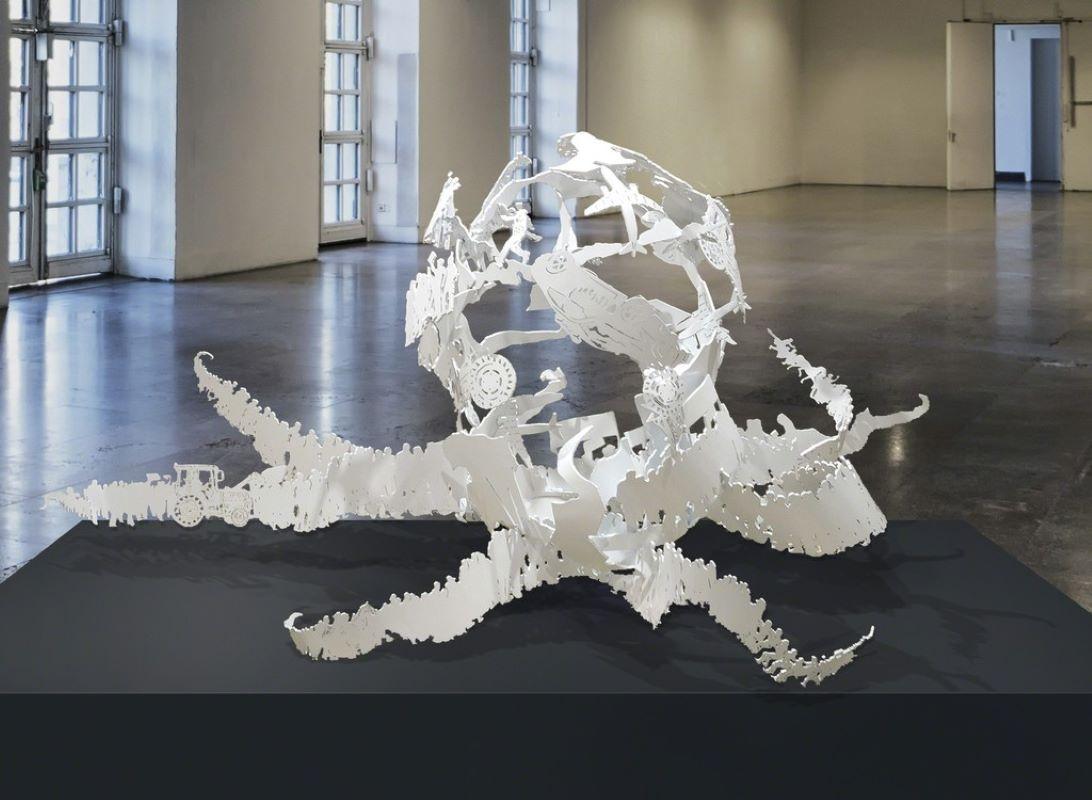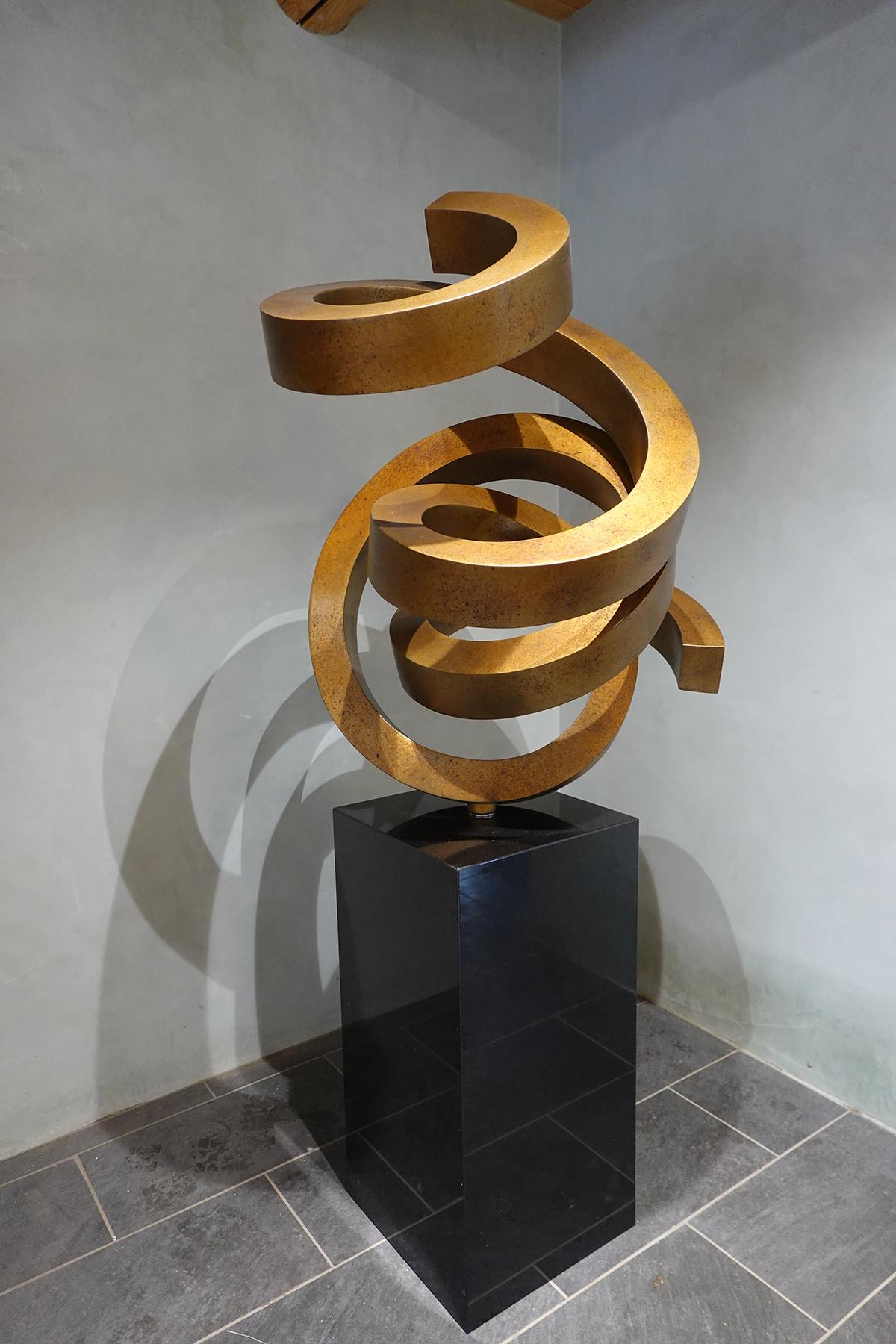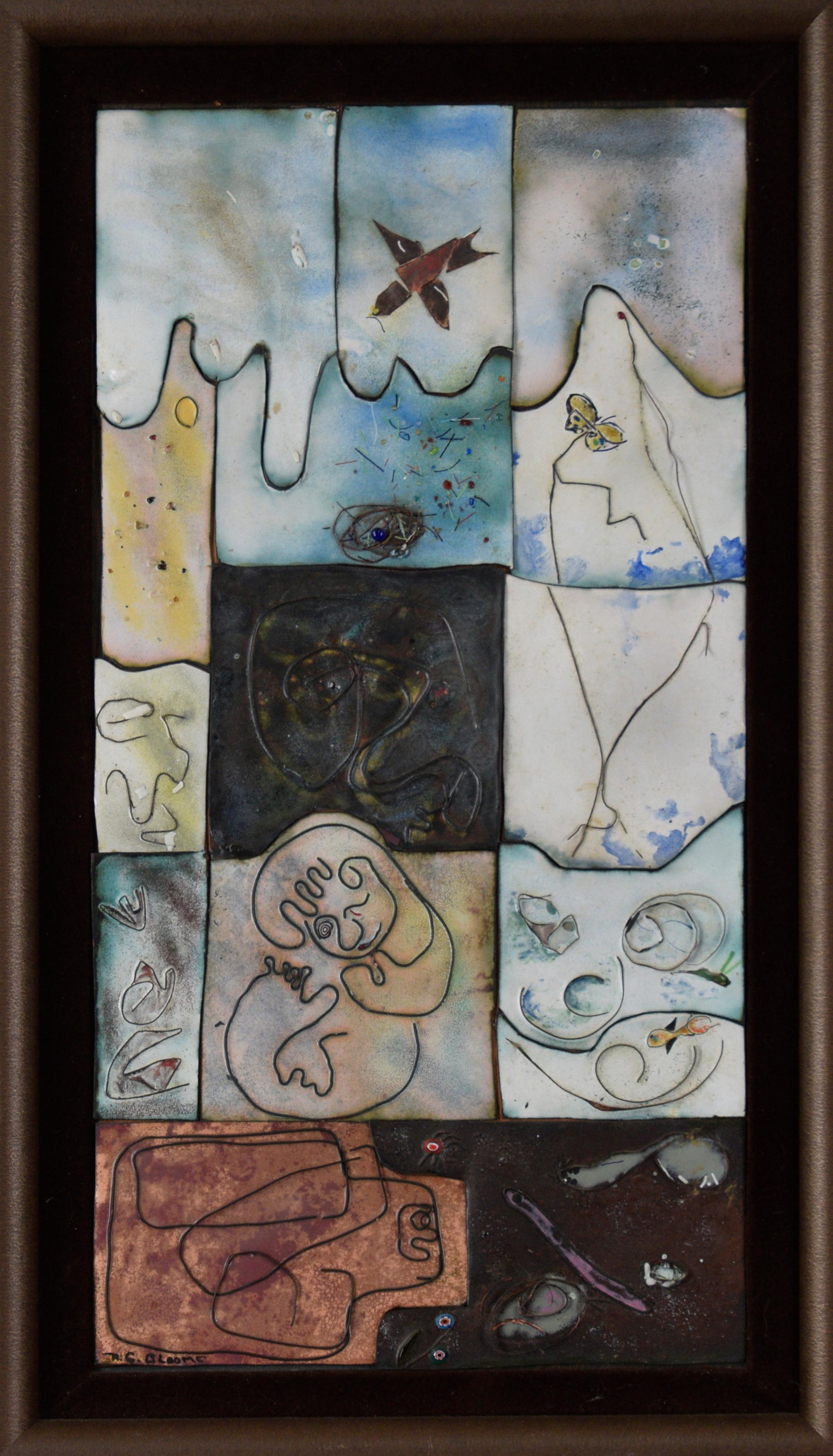Items Similar to Mid Century Modern Brutalist Welded Expressionist Sculpture
Want more images or videos?
Request additional images or videos from the seller
1 of 6
UnknownMid Century Modern Brutalist Welded Expressionist Sculpture
About the Item
In this bronze sculpture the artist (unknown) has welded together a group of figures into a unified piece. These figures take on animal, and human characteristics, which is evident in the shape of their bodies and faces.
Neo-Dada Abstract Sculpture: Assemblages
In contrast, abstract sculpture followed a slightly different course. Rather than focusing on non-figurative subject matter, it concentrated on materials, hence the emergence of Assemblage Art - a form of three-dimensional visual art made from everyday objects, said to be 'found' by the artist (objets trouves). Popular in the 1950s and 1960s in America, assemblage effectively bridged the gap between collage and sculpture, while its use of non-art materials - a feature of Neo-Dada art - anticipated the use of mass-produced objects in Pop-Art. Assemblage sculpture is exemplified by the works of Louise Nevelson (1899-1988), such as Mirror Image 1 (1969, Museum of Fine Arts, Houston), and by Jean Dubuffet (1901-85) and his Monument with Standing Beast (1960, James R. Thompson Center, Chicago). The idiom was considerably boosted by an important exhibition -The Art of Assemblage - at the Museum of Modern Art, in New York, in 1961.
Other examples of the Neo-Dadaist-style "junk art" include Hudson River Landscape (1951, Whitney Museum of American Art) and Australia (1951, MoMA, NY), both by David Smith (1906-1965); Untitled (wood, metal pieces, nails) (1960, Museum of Modern Art NYC) by Jesus Rafael Soto (b.1923); and certain "combines" by Robert Rauschenberg (1925-2008), such as First Landing Jump (made from: painting, cloth, metal, leather, electric fixture, cable, oil paint, board) (1961, MoMA, NY). Untitled (industrial felt) (1967, Kunsthalle, Hamburg) by Robert Morris (b.1931) is a further example of the use of unusual materials in sculpture, as is the minimalist Monument For Vladimir Tatlin (neon-lighting tubes) (1975, Musee National d'Art Moderne, George Pompidou Centre) by Dan Flavin (1933-96).
Dada also exalted nonsense-art, and what is more absurd than a sculpture that self-destructs? No doubt this was an important element in the philosophy behind the work of Jean Tinguely (1925-91), the unsurpassed master of self-destructing sculpture, whose masterpiece is generally reckoned to be Homage to New York (1960, Museum of Modern Art, New York).
An excellent example of abstract pop sculpture is the word art genre adopted by Robert Indiana (b.1928) in his series of LOVE sculptures.
Abstract Metal Sculpture (1960-onwards)
The 1960s also witnessed the beginning of a new broad tradition of metal sculpture, ranging from the portable to the monumental. Such works included: Sculpture For a Large Wall (1956-7, MoMA, NY) by Ellsworth Kelly (b.1923); Midday (1960, MoMA, NY) by Sir Anthony Caro (1924-2013); Die (1962, MoMA, NY) by Tony Smith (1912-1980); Broken Obelisk (1963-9, MoMA, NY) by Barnett Newman (1905-70); Storm Angel (1973-4, Square Chabas, Chalon-sur-Saone) by Mark Di Suvero (b.1933); and a number of works by Eduardo Chillida (1925-2002), culminating in his coastline sculpture Wind Comb (1977, Bay of San Sebastian, Spain).
- Dimensions:Height: 9 in (22.86 cm)Width: 7.5 in (19.05 cm)Depth: 7.25 in (18.42 cm)
- Medium:
- Movement & Style:
- Period:
- Condition:minor dust and wear. original patina to the piece.
- Gallery Location:Surfside, FL
- Reference Number:
About the Seller
4.9
Platinum Seller
These expertly vetted sellers are 1stDibs' most experienced sellers and are rated highest by our customers.
Established in 1995
1stDibs seller since 2014
1,549 sales on 1stDibs
Typical response time: 1 hour
- ShippingRetrieving quote...Ships From: Surfside, FL
- Return PolicyA return for this item may be initiated within 3 days of delivery.
More From This SellerView All
- Vintage Abstract Expressionist Ibram Lassaw Modernist Bronze Sculpture PendantBy Ibram LassawLocated in Surfside, FLIBRAM LASSAW (Russian-American, 1913-2003), Sculptural pendant Gold plated bronze Signed verso Measurements: 2-7/8''h, 2-1/4''w. Ibram Lassaw was born in Alexandria, Egypt, of Russian Jewish émigré parents. After briefly living in Marseille, France, Naples, Italy Tunis, Malta, and Constantinople, Turkey his family settled in Brooklyn, New York, in 1921.His family settled in Brooklyn, New York. He became a US citizen in 1928. Ibram Lassaw, one of America's first abstract sculptors, was best known for his open-space welded sculptures of bronze, silver, copper and steel. Drawing from Surrealism, Constructivism, and Cubism, Lassaw pioneered an innovative welding technique that allowed him to create dynamic, intricate, and expressive works in three dimensions. As a result, he was a key force in shaping New York School sculpture.He first studied sculpture in 1926 at the Clay Club and later at the Beaux-Arts Institute of Design in New York. He made abstract paintings and drawings influenced by Kandinsky, Sophie Taeuber Arp, and other artists. He also attended the City College of New York. Lassaw’s encounter with avant-garde art in the International Exhibition of Modern Art (1926), organized by the Société Anonyme at the Brooklyn Museum, made a powerful impression on him. In the early 1930s he explored new materials and notions of open-space sculpture. The ideas of László Moholy-Nagy and Buckminster Fuller were important to him, and he knew the work of Julio González, Pablo Picasso, and the Russian Constructivists. After experimenting with plaster, rubber and wire, Lassaw began working with steel, which became a frequent medium for the artist, along with other metals. His work reflects the influence of Surrealist artists such as Alberto Giacometti and Joan Miro as well as American Modernist Alexander Calder.A pioneer of abstract sculpture in the United States, in 1936 Lassaw was a founding member of the organization American Abstract Artists. Between 1933 and 1942 he worked for various federal arts projects: the Public Works of Art Project, Civil Works Authority, and WPA, the Works Progress Administration Federal Art Project. In 1938 he produced his first welded work. He served with the U.S. Army, where he learned direct welding techniques. During the 1940s he experimented with cage constructions and with acrylic plastics, adding color to his sculptures by applying dye directly to their surfaces. In 1949 Lassaw was a founder of the Club, an informal discussion group of avant-garde artists that had developed from gatherings at his studio, on Eighth Street. During the mid-1930s, Lassaw worked briefly for the Public Works of Art Project cleaning sculptural monuments around New York City. He subsequently joined the WPA as a teacher and sculptor until he was drafted into the army in 1942. Lassaw's contribution to the advancement of sculptural abstraction went beyond mere formal innovation; his promotion of modernist styles during the 1930s did much to insure the growth of abstract art in the United States. He was one of the founding members of the American Abstract Artists group, and served as president of the American Abstract Artists organization from 1946 to 1949. In 1951, Samuel Kootz invited Lassaw to join his gallery in New York. He also had a summer gallery in Provincetown, MA. Lassaw had been summering in Provincetown since 1944, and in 1951 rented an apartment next door to the Kootz Gallery. Among the artists in the Kootz Gallery were Jean Arp, William Baziotes, Georges Braque, Jean Dubuffet, Herbert Ferber, Arshile Gorky, Adolph Gottlieb, David Hare, Hans Hofmann, Fernand Leger, Georges Mathieu, Joan Miró, Robert Motherwell, Pablo Picasso, Pierre Soulages, and Maurice de Vlaminck. Lassaw is a sculptor who was a part of the New York School of Abstract expressionism during the 1940s and 1950s. Jackson Pollock, Lee Krasner, James Brooks, Willem de Kooning, and several other artists like Lassaw spent summers on the Southern Shore of Long Island. Lassaw spent summers on Long Island from 1955 until he moved there permanently in 1963. SELECT EXHIBITIONS 1961 International Exhibition of Modern Jewelry 1890–1961, organized by the Worshipful Company of Goldsmiths in association with the Victoria and Albert Museum, London 1967 Exhibition of Jewelry by Painters and Sculptors, organized for circulation by MoMA 1973 Jewelry...Category
Mid-20th Century Abstract Expressionist Abstract Sculptures
MaterialsGold, Bronze
- Huge Untitled Painted Metal Assemblage Sculpture, aluminum with nuts and boltsBy Robert Goodnough, 1917-2010Located in Surfside, FLRobert Arthur Goodnough (AMERICAN, 1917-2010) Untitled oil on aluminum with nuts and bolts Provenance: Christie's Auction House from the estate of William F. Buckley and Patricia ...Category
20th Century Abstract Expressionist Abstract Sculptures
MaterialsMetal
- Mid Century Modern Brutalist Welded Expressionist Sculpture After Paul EvansLocated in Surfside, FLIn this bronze sculpture the artist (unknown) has welded together a group of totems or monuments into a unified piece. T Neo-Dada Abstract Sculpture: Assemblages In contrast, abstra...Category
Mid-20th Century Abstract Expressionist Abstract Sculptures
MaterialsMetal
- Abstract Expressionist Biomorphic Welded Metal SculptureBy Seymour LiptonLocated in Surfside, FLWelded, brazed sculpture on wooden base This is not signed or dated This work is unsigned. We were told it was the work of Seymour Lipton but as there is further documentation we are selling it as attributed and cannot guarantee it as such. Seymour Lipton (1903 – 1986) was an American abstract expressionist sculptor. He was a member of the New York School who gained widespread recognition in the 1950s. He initially trained as a dentist, like fellow sculptor Herbert Ferber, receiving his degree from Columbia University in 1927. In the late 1920s, he began to explore sculpture, creating clay portraits of family members and friends. His early choices of medium changed from wood to lead and then to bronze, and he is best known for his work in metal. Like his contemporary, Abstract Expressionist Jackson Pollock, and Arshile Gorky Lipton was influenced by Carl Jung’s work on the unconscious mind and the regenerative forces of nature. He translated these two-dimensional drawings into three-dimensional maquettes that enabled him to revise his ideas before creating the final sculpture. The forms that Lipton produced during this period were often zoomorphic, exemplifying the tension between the souls of nature and the automatism of the machine. He made several technical innovations, including brazing nickel silver rods onto sheets of Monel to create rust resistant forms. Seymour Lipton is best known for his textured torch welded metal sculptures...Category
1950s Abstract Expressionist Abstract Sculptures
MaterialsMetal
- Abstract Expressionist Patinated Metal Assemblage Sculpture Steel, Nuts, BoltsBy Robert Goodnough, 1917-2010Located in Surfside, FLRobert Arthur Goodnough (AMERICAN, 1917-2010) Untitled patina on steel with nuts and bolts Robert Goodnough (October 23, 1917 – October 2, 2010) was an American abstract express...Category
20th Century Abstract Expressionist Abstract Sculptures
MaterialsMetal
- Bronze Sculpture Abstract Brutalist Goat or Ram WPA Artist Mounted on BaseBy Benedict Michael TattiLocated in Surfside, FLBenedict Tatti (1917-1993) worked in New York city as a sculptor, painter, educator, and video artist. He studied stone and wood carving under Louis Slobodkin at the Roerich Museum. He later attended the Leonardo da Vinci School of Art studying under Attilio Piccirelli. In l939 he taught adult classes with the Teachers Project of the WPA and attended the Art Students League for three and a half years on full scholarship. He studied under William Zorach and Ossip Zadkine and later became Zorach’s assistant. Later in his career, he attended the Hans Hofmann School of Fine Arts. During World War II, Tatti served in the United States Army Air Force, where he spent three years assigned to variety of projects. In 1948, Benedict Tatti married Adele Rosenberg in New York City. Throughout his career, Tatti continuously experimented with various media. From 1952-1963, Tatti executed sculptural models of architectural and consumer products for the industrial designers, Raymond Loewy Associates; later he became a color consultant for the firm. In the 1960s, influenced by the Abstract Expressionists, Tatti turned from carving directly in wood and stone to creating assemblage architecture sculptures, using bronze metal and other industrial materials. He was included in the important show "Aspects de la Sculpture Americaine", at Galerie Claude Bernard Paris, France, in October 1960 along with Ibram Lassaw, Theodore Roszak, David Smith, Louise Bourgeois, Danese Corey, Dorothy Dehner, Lin Emery...Category
Mid-20th Century Abstract Expressionist Abstract Sculptures
MaterialsBronze
You May Also Like
- Concussion GardenBy Dionisios FragiasLocated in New York, NYDionisios Fragias is a New York -based artist born on the Greek island of Kefalonia and raised in New York City. He is the protege of the artist Jeff Koons whose years-long mentorshi...Category
2010s Abstract Expressionist Abstract Sculptures
MaterialsSteel
- The Afterparty (Octopus)By Dionisios FragiasLocated in New York, NYDionisios Fragias is a New York -based artist born on the Greek island of Kefalonia and raised in New York City. He is the protege of the artist Jeff Koons whose years-long mentorshi...Category
2010s Abstract Expressionist Abstract Sculptures
MaterialsSteel, Stainless Steel
- CycloneBy Gino MilesLocated in Boca Raton, FL46 x 32 x 32 inch bronze sculpture on 32 x 16 x 16 inch black granite baseCategory
21st Century and Contemporary Abstract Expressionist Abstract Sculptures
MaterialsBronze
- Multifaceted Copper Enamel Tiles Abstract by N.G. BloomeLocated in Soquel, CAMultifaceted Copper Enamel Tiles Abstract by N.G. Bloome Enameled Copper panels "Picasso" esq by an unknown artist. N.G. Bloome (American, 20th C). Uniq...Category
1980s Abstract Expressionist Abstract Sculptures
MaterialsCopper, Enamel, Wire
- Untitled signed sculpture, from the collection of Dick Polich, Tallix FoundryBy Stephen TalasnikLocated in New York, NYStephen Talasnik Untitled sculpture, from the collection of Dick Polich, Tallix Foundry, ca. 1997 Cast light metal signed by the artist on the work (see close up photograph) 6 3/5 × 12 × 4 inches Provenance Estate of Dick Polich, founder of the legendary Tallix Foundry and Polich Art works Beacon, NY Manufacturer Stephen Talasnik at Tallix Foundry, Beacon, New York This work is signed by the artist (see close up photograh) Abstract metal sculpture The work is lightweight so it is believed to be in aluminum or an aluminum alloy, Provenance: acquired from the Estate of Dick Polich - founder of the legendary Tallix foundry and Polich Art Works. Polich and Tallix fabricated significant sculptural works over many years, collaborating with such as, Willem de Kooning, Jeff Koons, Roy Lichtenstein, Frank Stella, Helen Frankenthaler, ERTE, Julian Schnabel, Richard Artschwager, Isamu Noguchi, Isaac Witkin...Category
1990s Abstract Expressionist Abstract Sculptures
MaterialsMetal
- Tea Party #3By Sasson SofferLocated in New York, NYAbstract stainless steel pipe sculpture with beautifully detailed surface. Can be inside or outside. About the Artist: Famous abstract expressionist. Soffer was born in Bagh...Category
1980s Abstract Expressionist Abstract Sculptures
MaterialsStainless Steel
Recently Viewed
View AllMore Ways To Browse
Modern Shapes Sculpture
Sculptured Lighting
Midcentury Abstract Sculpture
Square Sculpture
Vintage Welding
Metal Midcentury Sculpture
Mass Modern
Unusual Sculpture
Large Midcentury Modern Sculpture
Vintage Moma
Midcentury Modern Standing
Welding Sculptures
Weld Art
Large Modern Abstract Sculpture
Mid Century Modern 1967
Weld Work
Australian Mid Century
Chicago Vintage Mid Century





